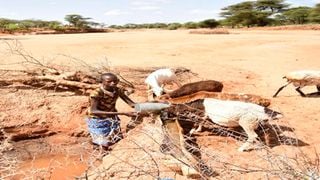
A Samburu herds boy watering livestock at a riverbed.
| File | Nation Media GroupIsiolo
Premium
Pastoralism at a crossroads after decade of intermittent drought
About 100 kilometres east of Isiolo town is Kulamawe, an expansive land mass whose Swahili name, directly translated, means ‘eat stones’.
And the name aptly captures the dire food situation here for both livestock and residents.
The land is bare, sweltering hot throughout the year and every corner invariably dotted with acacias and shrubs. On our way to Kulamawe, we occasionally spot a herd of goats and sheep being shepherded by two or three young men.
Another common sight here is that of donkeys with water containers strapped to their backs.
As the rest of the world struggles with Covid-19, the residents of this place are unbothered by the pandemic. The most immediate concern is feeds for their animals, their sole source of livelihood.
Protruding ribs
In one homestead, about six goats and sheep rest in the backyard, their scrawny necks and protruding ribs a summary of the woes residents have encountered in efforts to feed their livestock.
The owner tells us that the animals in the compound were left behind as they are too weak to trek – sometimes over more than 30km - in search of grazing areas.
The prolonged drought has depleted nearly all pastures in this part of the former North Eastern province, threatening pastoralism, the economic mainstay of the communities in this region.
Kulamawe grazing committee chairman Abdul Salesa explained that, traditionally, the area has been zoned into three sections.
There are the wet season grazing areas, the dry season areas and the drought-reserve area.
Mr Salesa explains that the pastoralists normally move into the drought-reserve areas in October.
No rain
These, however, are not normal times. The last time this area received rainfall for two consecutive seasons was 10 years ago; short rains from October to December and long rains in March to May.
This year, a sad Mr Salase reveals, they had rains for only three days back in April.
“We used to enter drought-reserve areas in October before it rains and return to wet season grazing areas in mid-October when the rains poured. But over the past five years we have been entering the drought-reserve in June or July,” he says.
Kulamawe residents rely on water that is pumped from a borehole situated at the administration post.
The water caters for their domestic needs and their livestock. Their main headache, however, is livestock feed.
“Due to climate change and the resultant drought, forage hardly grows,” Mr Salase explains. “Getting into the drought-reserve areas as early as June means we are in danger. The pastures are depleted. If rain does fall in 15 to 20 days, these animals will be dropping dead.”
Supplementary feeds
Herders have resorted to supplementary feeds such as pellets, sorghum and acacia pods. Some feed their animals human foodstuffs such as maize.
“A 100kg bag of acacia ponds or pellets from Rapsu costs Sh1,500 and we still have to pay for a motorbike. Many can’t afford that, so they opt for maize,” Mr Salesa adds.
A 1ookg bag of pellets can feed five goats for three to four weeks or 20 goats for two days.
To get money for sorghum, acacia pods or pellets, some households sell their livestock.
The emaciated animals however attract poor prices, making it hard for a majority of the residents to afford food.
Children and the elderly are also at risk of malnutrition and ill health due to dependency on livestock products like milk and meat.
A big goat that normally sells at Sh10,000 now goes for Sh6,000.
“Some buyers even tell you the animal is too weak, so you should just sell the skin to them,” he adds.
Hides fetch from Sh100 to Sh150.
In Garbatula, 43-year-old Isaack Halkano, who has five children and takes care of two of his sister’s, has lost 20 goats out of the 40 he had.
“I have only seen this kind of drought only two times since I was born. I have to spend Sh500 on food daily but even after selling my livestock I can’t get that money daily,” Mr Halkano says.
Animal carcasses in Mlima Chui
On the western side of Isiolo town is another area called Mlima Chui in Oldonyori ward.
The air here is heavy with the stench of dead animals.
Mr David Luis, a father of three who is living with disability, tells the Nation he has lost three cows and six goats and is now left with 10 goats.
In the backyard of his home is a rotting carcass of a cow.
“One cow was attacked by a lion and another died because it was too weak to get back here. Every homestead here has lost animals,” Mr Luis says.
“The remaining goats can hardly fetch Sh1,500, which is half of the price at which I sell at Oldonyiro market.
To survive perennial drought, he started keeping chickens in 2018, hoping to sell eggs to sustain his family. But that venture too has faced a myriad of challenges.
Unsuitable for farming
Just like Kulamawe, Oldonyiro is a dry, rocky expanse and, therefore, unsuitable for farming. The residents hope the rain will fall later this month.
Poverty has worsened in these areas, where residents rely on animals for survival. “If people are struggling to buy food, what else can they buy?” asks Mr Ali Dagane, 36, who runs a shop at the Garbatulla market.
“Most of the people here don’t have jobs and food prices are constantly rising. It is much better living in Nairobi,” he adds.
A woman cuts short our interview. We soon learn that she is inquiring whether she can wash clothes for a fee but is told to check next week.
Mr Dagane buys stock from Maua, 80km away.
He, however, says sales have tanked lately, as people relied on the now non-existent construction, herding and laundry jobs to feed their families.
“Out of every five people who walk in here, two people are asking for items for free. They no longer even promise to pay later as they are no sure of any income any time soon,” the shopkeeper notes.
“Not long ago, with Sh200 you could feed your family for a whole day,” he explains.
Cooking oil
He says a 200ml cupful of cooking oil now goes for Sh60, up from Sh40 two months ago, while the price of a kilo of maize flour has risen from Sh50 to Sh70.
Ms Amina Alsime, who runs Umoja General Shop, buys 20 litres of cooking oil at Sh4,100.
Cabbage, which sells at Sh30 to Sh40 in Nairobi, here goes for a wholesale price of Sh60 and a retail price of Sh70.
“If I had money I would have boosted my stock. I have educated six children courtesy of this shop but now it’s tough, especially as they are yet to get jobs in Nairobi,” Ms Alsime says.
“Since Covid-19 struck, business has been slow. We don’t have good farms like other villages to cultivate. We depend on livestock to buy food and to buy school uniform, but it is getting worse,” says Ms Habiba Salad, a mother of four who sells Miraa at the market.
“We have had Covid-19, locust invasion and three seasons of failed rains,” World Food Programme head of refugee and relief operations, Mr Felix Okech, said.
“The situation is bad. There is dire need for preparedness to mitigate cycles of drought before it happens. We are looking for resources to respond to this,” he added.
The herders are pleading for supplementary feeds.
Livestock banking
Another intervention they proposed is livestock banking - where the national government, the county administration, a private organisation or other actors take over management of livestock on behalf of the herders during difficult periods. The animals are then returned to their owners once the bad times end for a fee.
“Livestock banking has been applied in Wajir County and could also work here. Most interventions come when the animals have died,” Mr Salesa adds, ruefully.





